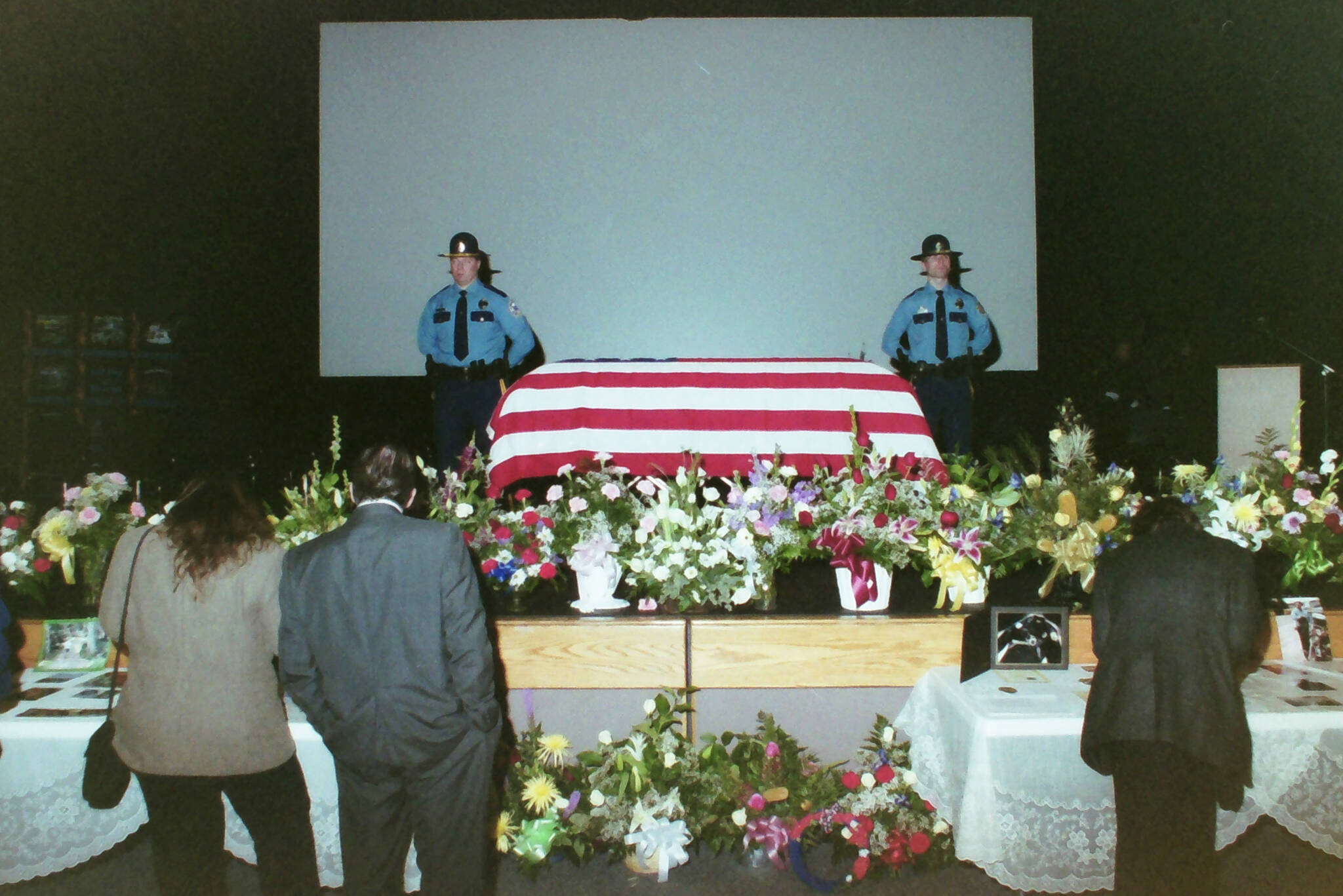On the south wall at the end of a long hallway inside the Kenai Police Department is a large quilt adorned with stars and stripes. A sign on the wall explains that the use of red is intended to symbolize the courage police officers show while serving their communities, while the blue stripes symbolize the “thin blue line” imagery associated with police officers.
Called the “In the Line of Duty” quilt, it was donated to the Kenai Police Department in 2003 after the death of Kenai Police Officer John Watson, who was killed while responding to a domestic violence call on Christmas Day. Watson, then an 18-year veteran of the department, was the first and remains the only police officer on the Kenai Peninsula to be killed in the line of duty.
The quilt, made by Sheryl Weedin and donated by Jennifer Dye and Phyllis Ann Halstead, is just one tribute to Watson on display in the Kenai Police Department. A memorial plaque hung near the department’s main entrance dedicates the building to Watson and remembers that he served “with honor, integrity and valor.”
Twenty years after Watson’s death, Kenai Police Chief David Ross remembers him as a well-liked officer who the community rallied around.
“He was the 18-year older officer that already knew everything, and I was brand new,” Ross said of Watson on Thursday. “I didn’t train with him, but he was a wealth of knowledge.”
Watson was responding to the residence of David Forster, on Watergate Way in Kenai’s VIP subdivision, when he died. After attempting to place Forster under arrest, Forster took Watson’s gun and fatally shot Watson. Forster was arrested after a four-hour standoff with police and in 2005 was sentenced to 101 years in prison for Watson’s murder and three related assaults.
Watson left behind his wife, Kathy, their daughter, and six stepchildren. He was remembered in his obituary as someone who “enjoyed his family, friends, the outdoors and riding his Harley-Davidson motorcycle.” Watson was a U.S. Army veteran and had also worked for the Anchorage Police Department.
“It was very somber,” Ross remembers of learning about Watson’s death. “It was very surreal.”
Ross started at the Kenai Police Department in 2001, two years before Watson was killed. He drove one of the police vehicles in what he estimates was a 2-mile long parade from the mortuary to Kenai Central High School on the day of Watson’s memorial — a large affair that was attended by Alaska State Troopers, members of the Kenai Police Department and then-Lt. Gov. Loren Leman, among others.
“One thing good for officers to see is how much community support there is for law enforcement and for a law enforcement officer that made that sacrifice,” Ross said.
Today, there are only four people at the Kenai Police Department who served alongside Watson, including Ross. In the 20 years since Watson’s death, Ross said the department has made some changes.
There used to be a certain time of day, for example, when only one officer may be on duty in Kenai. Now, there are always at least two. Although multiple officers were on duty at the time of Watson’s death, Ross said the extra person means backup is always available. Kenai officers also now have tasers, which they didn’t carry in 2003.
“It was shortly after that (incident) that we got those, and I think there was a connection there,” Ross said. “Whether or not we would have got them anyway … that helped us see that anything we can do to train or provide tools for our officers for those potentially dangerous or lethal encounters is critical.”
There have also been some advances in the way department officers are trained, Ross said, particularly regarding de-escalation and critical incident situations. Officers generally also have more less-lethal options than in 2003 and a newer model of gun holster that’s supposed to have a better retention system.
“There’s ongoing training to make our officers better prepared for those events and continued advancements in equipment that helped with that as well,” he said.
It’s hard to know, Ross said, whether anything could have been done differently in 2003 that would have meant Watson walked away.
“It’s a dangerous job,” he said. “It’s important for our people to know that — and they do know. John’s a reminder that this danger can happen really fast, and that our officers need to be vigilant, they need to be cautious, they need to ask for help when they need help, and they need to be prepared, because, you know, we want them all to go home at night after their shift.”
Ross pointed to the engagement on a recent social media post made by the department in memory of Watson, which received dozens of comments and more than 400 likes and other reactions. It’s an indicator, Ross said, that Watson’s legacy is larger than the Kenai Police Department.
“Hundreds of people knew him and knew of this event or knew him personally or were around that night,” Ross said. “ … There’s a lot of people that remember him and honor that sacrifice, from current politicians to current government employees to retired — definitely a lot of retired folks — from law enforcement and public safety that try hard to remember and honor him.”
Reach reporter Ashlyn O’Hara at ashlyn.ohara@peninsulaclarion.com.

